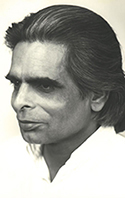To spread the original, universal and eternal truth, path or law of yoga, which remains forever the same in essence, yet always adapts to the time and place. |
|
The name of Rahu first appears in the Mahabharata, when we read the story of the churning of the Ocean of Milk in the search for ambrosia - the elixir of immortality known as amrita in Sanskrit. Rahu was the son of Danava Vipracitti by his wife Simhika, and a brother of Maya Danava, the great magician and architect. Rahu and Ketu are two parts of the same danava and are 180° apart from each other. Whenever either Sun or Moon are conjunct with Rahu or Ketu, a solar or lunar eclipse takes place. In astronomy Rahu is considered the dragon's head and is also known as the north node of Moon, the point where the Moon's orbit crosses the ecliptic. Ketu is known as the dragon's tail, which gives birth to comets and meteors and is known as the descending or the south node of the Moon. When Sun, Moon, and Rahu or Ketu fall in the same zodiacal longitude, a solar eclipse takes place. Rahu is responsible for solar, Ketu for lunar eclipse. This makes them significant for astronomers and astrologers both. Though they are included in planets, Rahu and Ketu are not real luminaries and are regarded as shadow planets. They do not have ability to cast aspects, as other planets do, they do not rule any zodiacal signs and are not characterized as male or female. Because they are related to Moon as its north and south nodes, they reflect the basic bipolarity of energy within the cosmos and the individual. They are both regarded as malefic half-planets and they bisect the natal chart of the horoscopes of all individuals. The gemstone related to Rahu is hessonite. Rahu rules number 4 in indian numerology. |
|
 Sanatan Society is an international networking association of students of the late Harish Johari, joining efforts to promote his teachings of yoga philosophy, tantra, worship, art and love. Sanatan Society stands
for the original, universal and eternal truth, path or law of yoga.
Though it is Hindu in origin, Sanatan Society is not limited to any religion,
race, time or country, nor in fact to any particular organisation. More about Sanatan Society...
Sanatan Society is an international networking association of students of the late Harish Johari, joining efforts to promote his teachings of yoga philosophy, tantra, worship, art and love. Sanatan Society stands
for the original, universal and eternal truth, path or law of yoga.
Though it is Hindu in origin, Sanatan Society is not limited to any religion,
race, time or country, nor in fact to any particular organisation. More about Sanatan Society...